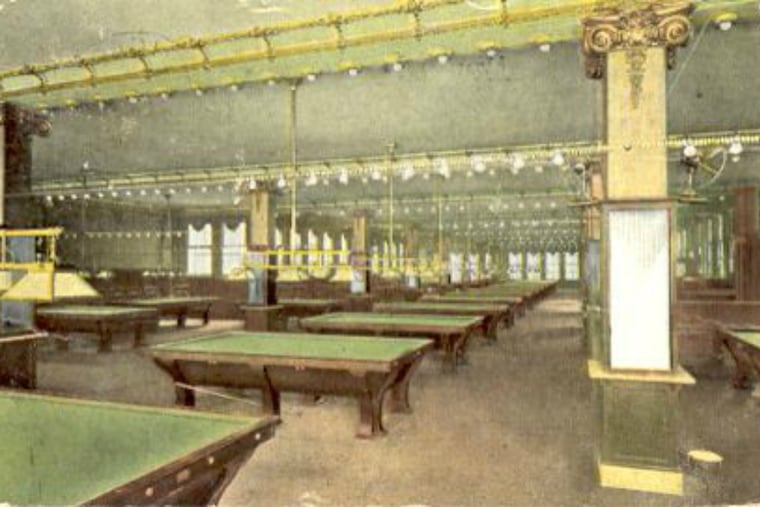Allinger's was 'fabulous' when pool was king in Philly
The old man we knew only as "Callahan" looked like the pool hustler he was. Each summer, as if arisen from a long hibernation, he would appear at the LP Lanes pool room, dressed in a way that less-confident men couldn't have pulled off. His entire ensemble - a starched, loosely fitted shirt; Bermuda shorts; knee-high socks; suede shoes, and a spiffy cap - was the the color of fresh cream.

The old man we knew only as "Callahan" looked like the pool hustler he was.
Each summer, as if arisen from a long hibernation, he would appear at the LP Lanes pool room, dressed in a way that less-confident men couldn't have pulled off. His entire ensemble - a starched, loosely fitted shirt; Bermuda shorts; knee-high socks; suede shoes, and a spiffy cap - was the the color of fresh cream.
He walked jauntily, possessed a Runyonesque cockiness, smoked cigars, and carried his custom-made cue in a fine leather case.
Most of the Philadelphia pool halls he'd frequented had shut down. In search of action, he'd been forced to travel to suburban shopping centers and bowling alleys where his opponents typically were players the age of his grandkids.
I was never competent enough to challenge, but I loved watching him and listening to his stories, especially those about Allinger's Billiards Academy. The memories, funny and heartfelt, lent him an air of sincerity he otherwise lacked.
If I were listing the vanished Philadelphia venues I wished I'd visited, that grand pool hall near 13th and Market Streets would rank high.
This city that was once a lot of things was once the capital of pool, or pocket billiards as the more respectable citizens termed the sport.
The first U.S. championships took place here in 1858 and, according to the Encyclopedia of Greater Philadelphia, the 1920 City Directory contained more than 200 listings under "Billiards" or "Pocket Billiards."
The nation's first publication devoted to the game, National Billiard News, began in Philadelphia in the 1950s, the product of a police detective named Earl Newby, who also ran a pool hall at 11th and Chestnut.
The best and largest of Philly's pool palaces were congregated in the heart of Center City. In addition to Allinger's and Newby's, some of the other popular ones included Longo's and Mosconi's.
Mosconi's was owned by Willie Mosconi, the South Philadelphian who not only became one of the world's top players but, as that 1961 film's technical adviser, made all those impossible shots in The Hustler.
He still holds the world record for most balls sunk in succession - a 526-ball run at a 1954 event in Ohio.
Jimmy Caras, another all-time pool great, was born in Wilmington but relocated here early on to test his game against the best.
By the time I became aware of Allinger's, in the late 1960s, the place held no appeal. It was a single upstairs room on a seedy and rundown block that also housed an adult-movie theater. The clientele was pretty much limited to drunks and degenerate gamblers.
But it had once been a billiards palace, "the high, holy place of pool," one writer called it in the 1940s.
At the height of its popularity, Allinger's had 100-plus tables spread over three floors of a building at 1307 Market St. On one floor, a glass-enclosed area allowed spectators to watch high-profile matches such as the 1954 national championships.
Its interior, said those who saw it, was as plush and elegant as those of exclusive urban men's clubs. The proprietors, eager not to validate prudish Philadelphia's natural distaste for pool, demanded a high level of decorum.
"They ran it like the Union League," Philadelphia nightclub owner Henry Diamond recalled in 1971. "If you spoke above a whisper, you were asked to leave."
An old postcard depicts dozens of evenly spaced tables in an enormous room that is also notable for its hardwood floors, elegant fixtures, and ample sunlight.
All sorts of amenities were offered to Allinger's patrons, many of whom used "rack girls," young women who, for tips, would reset a rack of balls after each game.
Not surprisingly, the top talent in the world was drawn there.
Mosconi and Caras were regulars, as were other legendary pool shooters such as Willie Hoppe, Ralph Greenleaf, and Minnesota Fats.
Asked once about the great pool halls he'd visited, Fats, real name Rudolph Wanderone, said "the most fabulous spot of all was Allinger's."
"I hung around Philly often for years," he noted in an autobiography cowritten with former Inquirer columnist Tom Fox, "because most of the top players were there, and you could get as much action as you wanted."
Pool's popularity probably peaked in the 1950s. In the end, much like golf, it was too difficult for the masses to master. Allinger's declined but hung on until its 1971 closing.
The building eventually was torn down in the mid-1990s as part of the Convention Center project. The site is now the parking lot adjacent to the Marriott.
Sometime after it disappeared, Lawrence Dugan titled one of his poems "Allinger's." A lament about progress' toll on urban landscapes, it includes this description of the down-on-its-heels pool hall:
[It] summarized all the dissipation
Of despair, the exaltation of hope.
The cardinal dimension was head
Over heart. I think gargoyles were watching
Outside. The place is a parking lot now.
One summer, just about the time our fascination with pool was ebbing, Callahan failed to show up.
Someone said he'd retired to Florida. Someone else thought he'd died.
I prefer to think he packed his fancy cue in that leather case and went looking for action somewhere else.
Somewhere where he could tell those stories he loved, the ones about a pool palace that time and progress turned into a parking lot.